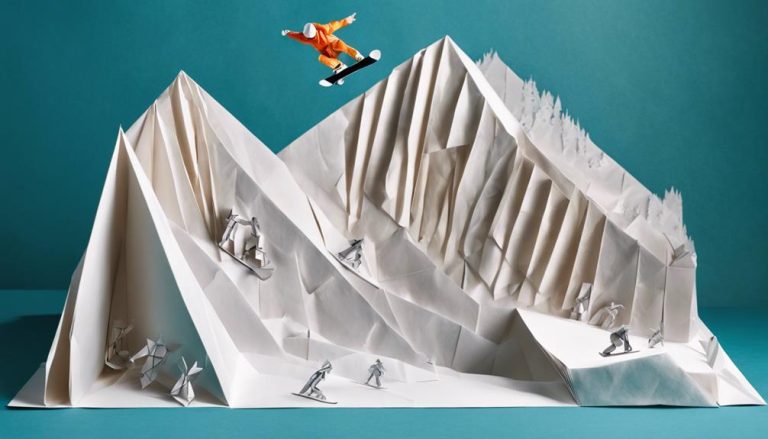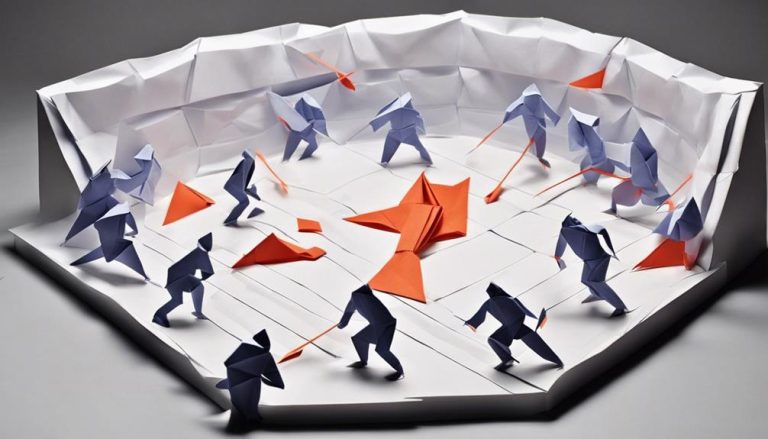General Rules of Ice Cross Downhill
Gear up with a helmet, gloves, knee and elbow pads, and padded clothes to race safely. Navigate high-speed tracks with twists, bumps, and tight corners to showcase your skills. Listen for the starter signals, harness the crowd's energy, and dominate the starting line. Wait for the perfect moment to pass rivals, signal your move, and be respectful on the track. Understand the penalty system and the importance of sponsors for a fair and thrilling competition. Uncover the winning criteria and podium protocol for the next level of excitement in ice cross downhill. Ready to embrace the thrill?
Safety Gear Requirements
When getting ready for Ice Cross Downhill, make sure you have the necessary safety gear to protect yourself on the icy course. The most important pieces of equipment you must have are a helmet and gloves. Your helmet is your best friend on the track, safeguarding your head from any unexpected falls or collisions. Make sure it fits snugly and meets safety standards. Gloves are essential for maintaining a good grip on your equipment, especially when maneuvering sharp turns and obstacles.
In addition to the helmet and gloves, other protective gear is also essential. Knee and elbow pads can prevent serious injuries in case of a tumble, while padded clothing can offer extra protection against the cold and potential impacts. Remember, safety should always come first when gearing up for Ice Cross Downhill. By ensuring you have the right protective gear, you can focus on enjoying the excitement of the race while staying safe on the challenging course.
Course Layout and Obstacles
Strap on your helmet and gear up because maneuvering the course layout and obstacles in Ice Cross Downhill requires skill, focus, and quick reflexes. Course design plays an important role in creating an exhilarating and challenging experience for riders. The tracks are filled with twists, turns, jumps, and obstacles strategically placed to test your abilities to the limit.
Each course is unique, offering a mix of high-speed sections and technical turns that demand precise control. The layout keeps racers on their toes, requiring them to adapt quickly to the changing terrain. As you navigate the icy track, you'll encounter a variety of obstacle challenges like bumps, rollers, and tight corners that will push your skills to the edge.
To conquer these courses, riders must have a keen eye for the best racing lines and the agility to tackle unexpected hurdles. The dynamic nature of the course keeps the adrenaline pumping and ensures that every race is a thrilling test of speed and skill. So, get ready to face the course design and conquer the obstacle challenges that await you in Ice Cross Downhill.
Starting Line Procedures
Ready to kick off your Ice Cross Downhill race with confidence and precision? Starting Line Procedures are essential for a successful start to your thrilling race. Here are some key points to keep in mind:
- Timing accuracy: Pay close attention to the timing devices at the starting line. Precise timing is vital for fair competition and accurate results. Stay focused and ready to burst out of the gates at the perfect moment.
- Starter signals: Listen attentively to the starter's signals. Whether it's a sound cue or a visual indication, being alert to the start signal can give you a competitive edge. Additionally, be mindful of the crowd dynamics around you; their energy can be contagious and spur you on to a great start.
- Crowd reactions: Use the energy of the crowd to your advantage. Let their cheers and excitement motivate you as you prepare to launch into the race. Channel their positive vibes into your performance for a thrilling start that sets the tone for the rest of the competition.
Get ready to embrace the adrenaline and conquer the starting line with finesse!
Passing and Blocking Rules
Traversing the ice-cross track demands a sharp grasp of the Passing and Blocking Rules to ensure a competitive and safe race for all participants. When it comes to passing techniques, timing is essential. Look for openings and swiftly make your move, using your speed and skills to overtake opponents. Strategic positioning is key; aim to anticipate your rivals' next moves and position yourself to block them while staying within the rules.
Let's break down the Passing and Blocking Rules to help you navigate the icy course effectively:
| Passing Rules | Blocking Rules |
|---|---|
| Wait for the right moment to pass | Avoid intentional blocking |
| Signal your intention to pass | Maintain a fair racing line |
| Overtake safely without causing collisions | Do not push or shove opponents |
| Respect your competitors' space | Be aware of your surroundings |
Penalty System and Disqualifications
Traversing the ice-cross track effectively requires a clear understanding of the Penalty System and Disqualifications in place to maintain fairness and safety during races. To guarantee a consistent and fair competition, the enforcement of penalties and disqualifications follows specific guidelines:
- Enforcement Consistency: The penalty system is designed to be applied consistently throughout the race. This ensures that all athletes are treated fairly and that the rules are upheld uniformly.
- Athlete Appeals: In the event of a penalty or disqualification, athletes have the right to appeal the decision. This process allows for a review of the incident and ensures that athletes have a voice in the enforcement of the rules.
- Maintaining Fairness: The penalty system is not only about enforcing rules but also about maintaining fairness in the competition. By penalizing infractions and disqualifying athletes when necessary, the integrity of the sport is upheld, and safety on the track is prioritized.
Winning Criteria and Podium Protocol
Alright, let's talk about the POINTS in Ice Cross Downhill! Understanding the Winning Criteria will give you insight into what it takes to claim victory on the icy track. Discover the Podium Ceremony Etiquette and the precise process of the Awards Presentation.
Winning Criteria Explanation
When determining the winner in Ice Cross Downhill, the criteria used consider a combination of speed, skill, and strategy, culminating in a thrilling podium ceremony. Here is a deeper look at how the winners are determined:
- Speed: The first criterion is speed, as racers must navigate the icy track at breakneck speeds, showcasing their agility and control on the challenging course.
- Skill: Judges evaluate the technical skills of each competitor, including jumps, turns, and overtaking maneuvers, to determine their overall proficiency in the sport.
- Strategy: An important aspect is the strategic decisions made during the race, such as choosing the best racing line, overtaking opponents effectively, and adapting to changing track conditions, which can make a significant difference in the final outcome.
Podium Ceremony Etiquette
Exploring the thrilling world of Ice Cross Downhill, understanding the etiquette of the podium ceremony is essential for athletes and fans alike. When it comes to the podium ceremony, displaying respectful behavior and following etiquette guidelines is vital. Here are some key points to keep in mind:
| Podium Ceremony Etiquette | Tips for Athletes and Fans |
|---|---|
| 1. Respect the National Anthems | – Stand up straight. |
| – Remove hats and helmets. | |
| 2. Congratulate Competitors | – Handshakes or high-fives. |
| – Smile and show sportsmanship. | |
| 3. Pay Attention to Officials | – Follow instructions. |
| – Wait for your turn. | |
| 4. Celebrate Modestly | – Be gracious in victory. |
| – Avoid excessive celebrations. |
Awards Presentation Process
Begin by getting familiar with the winning criteria and podium protocol to fully grasp the awards presentation process in Ice Cross Downhill. When it comes to the awards presentation, the following aspects play an important role:
- Trophy Design and Timing: The design of the trophy often reflects the essence of the sport, with intricate details that symbolize speed and adrenaline. The timing of the awards presentation is vital to maintain the excitement and engagement of the event.
- Sponsor Recognition and Media Coverage: Sponsors play a significant role in the success of Ice Cross Downhill events. Acknowledging their support during the awards ceremony is crucial. Additionally, media coverage helps to promote the sport and the achievements of the athletes to a broader audience.
Understanding these elements enhances the overall experience of the awards presentation in Ice Cross Downhill.
Frequently Asked Questions
Are There Age Restrictions for Participating in Ice Cross Downhill Races?
You must meet the age requirements to race in ice cross downhill events. Experience and training are essential for eligibility. Get ready to push your limits and experience the thrill of this high-speed sport!
How Are the Races Organized and Scheduled Throughout the Season?
Imagine a thrilling season where race formats vary, from intense head-to-head battles to high-speed group races. The competition schedule is packed with excitement, offering diverse challenges and showcasing top athletes in epic showdowns.
Is There a Limit to the Number of Competitors Allowed on the Course at One Time?
When it comes to competitor spacing in Ice Cross Downhill, there's definitely a limit to the number of racers allowed on the course at one time. Course capacity is carefully managed for safety and fair competition.
Are There Any Specific Rules Regarding the Maintenance and Preparation of the Ice Track?
Maintaining and preparing the ice track is vital for safety in Ice Cross Downhill. Follow specific rules for ice track maintenance and preparation to guarantee a smooth and secure course for all competitors.
What Measures Are in Place to Ensure the Safety of Spectators Watching the Races?
To guarantee spectator safety during the races, event planning includes strategic placement of barriers, security personnel, and emergency medical services. These measures aim to provide an exhilarating experience while prioritizing the well-being of all attendees.






